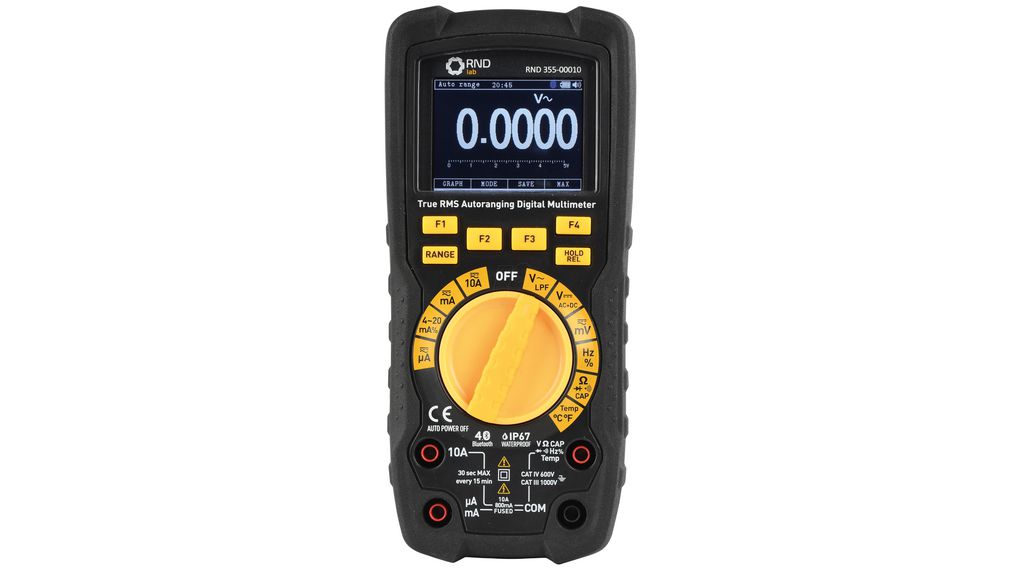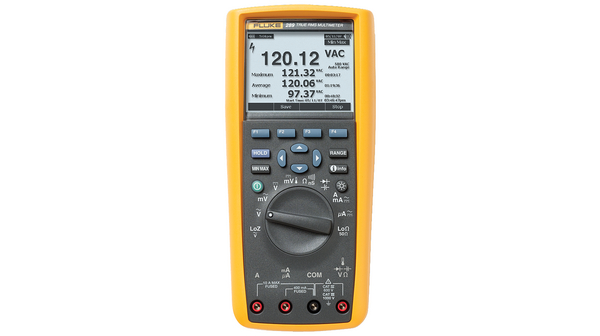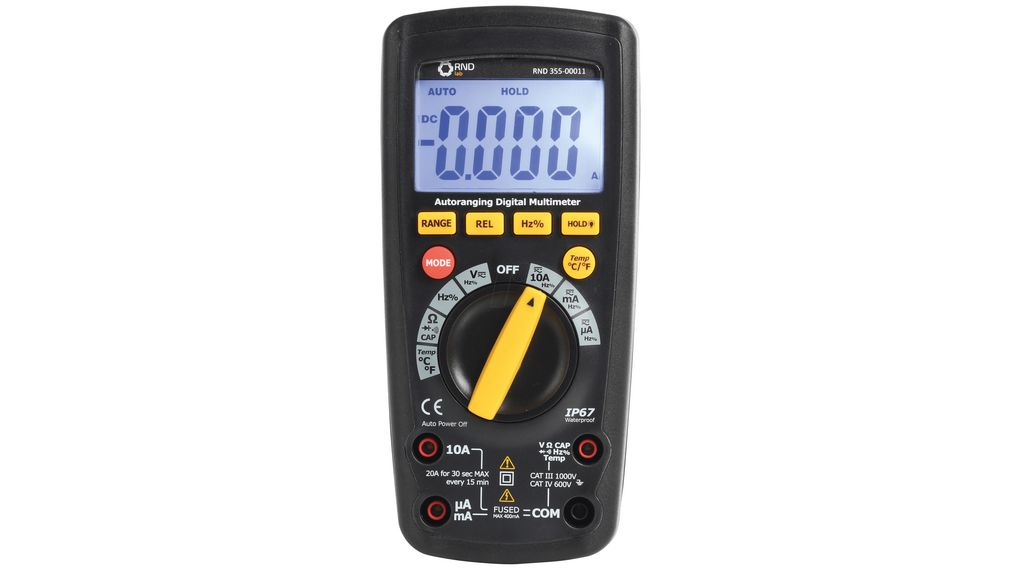Digital multimeters are without a doubt the most frequently used measuring tools in the fields of electrical engineering and electronics. In keeping with their popularity, the selection of models is vast. This guide will help you make the right choice for your application.

Multimeters general usage
A multimeter is used to measure the basic electrical quantities of current, voltage (AC+DC) and resistance. This versatility is what earned them their name: ‘multi’ (=many) ‘meter’ (=measuring). Most multimeters also enable you to measure additional quantities, such as capacitance, frequency or temperature. At its core, a multimeter is a compact and versatile tool.
The customary term “digital multimeter” is derived from the tool’s method of measurement rather than its digital display. Almost all multimeters use a digital measurement method, meaning that the initial analogue data collected is converted into digital signals and further processed by an A-D converter that’s integrated into the multimeter. Features such as autoranging or controlling the digital display establish a requirement for digital information. Even so, digital multimeters with an analogue display are also an option – these devices display readings in analogue bar graphs or by imitating a gauge.
How to use a digital multimeter?
If you know already the main usage of multimeters, make sure that before starting any of your applications (either monitoring, analysis, troubleshooting or detection) you take into account settings and methods. Common include:
- Setting up the right measurement accuracy and resolution.
- Measuring the current passing across a circuit.
- Testing diodes.
- Measuring the frequency of AC signals.
- Checking the capacitor’s value.
- Testing switches, connectors, and fuses for continuance.
- Measuring temperature.
Accuracy and resolution
A multimeter’s measurement accuracy can be the deciding factor when picking between different models. Matching a circuit’s voltage exactly, for instance, requires a higher voltage accuracy than general electric testing.
Accuracy can be measured as a percentage, taken either from the final value of the set measuring range or from the measured value. The difference between these two is sizable, and it is wise to consult the data sheet to determine what value your multimeter is advertising. As a rule of thumb, AC measurements are much less precise than DC measurements.
Resolution is defined as the smallest measurement differential a multimeter can recognise. A multimeter will have different resolutions for different measurement ranges. Usually, the resolution is high enough to deliver good results within the basic accuracy range.

Price range
There is an extensive range of multimeters available for purchase, and hence the price range can differ as well. A hobbyist might be looking for limited functionality available in basic multimeters, ranging from EUR 10-100 in price. Cheaper multimeters have a sampling speed of two times per second, which generally is not high enough for professional applications. The low price range for professionals starts at EUR 100. Mid-range professional products cost between EUR 200-500, and high-end multimeters can cost from EUR 500-1500 – a high price tag that is justified by their high specifications.
Additional features
The real differences between multimeters that go beyond the most basic functionality of measuring current, voltage and resistance start to show when we get into the list of additional features that can be provided. With some multimeters, capacitance, frequency, continuity, diode and duty cycle can also be tested.We have compiled a few additional features that multimeters can offer and might influence your purchasing decision:
| Feature | Function | Benefits |
|---|---|---|
| Autoranging | Adjusts multimeter automatically to the measurement range for inputs | Saves time and minimizes the measurement error |
| Transistor testing circuits | Checks whether transistor is functioning | Useful in testing digital logic circuits and integrated circuits |
| Display rate | Represents speed at which digital display refreshes | Faster display rates mean more accurate readings |
| “Hold” function | Keeps the display from changing | Useful when noting readings |
| Display with large digits and backlight | Designed for ease of use | Easy to read, even in dark crawl spaces and basements where electrical systems may run |
| ISO or NIST calibration | Indicate compliance for certified companies | Ensures highest levels of accuracy in reading |
| Calibration | Multimeter comes calibrated | Calibrated parameter’s measuring tolerance is guaranteed |
| Graphic representation | Quantity under test shown i.e. as a bar graph | Allows spotting of fast-moving trends |
| Adjustable sample rating | Represents speed at which samples are taken | Faster sample rates mean more accurate readings |
| Removable data storage | Measured data stored in removable component | Ability to access data on different devices |
| Data acquisition | Sampled signals values are saved into device’s memory | Records readings over given period, takes number of samples at fixed intervals |
| Low pass filter | Only allows signals up to a frequency limit of f(x) | For measuring variable frequency drives (VFD) |
True-RMS
Measuring non-sinusoidal alternating currents requires a multimeter with the true-RMS feature. Some examples of environments in which true-RMS meters are needed are variable-speed motor drives, electronic ballasts, computers, HVAC and solid-state environments. Inhomogeneous alternating voltages or currents can only be measured correctly by a TRMS multimeters. Simple RMS multimeters always assume that the AC voltage under test is a sine wave – the reading is calculated via the mathematical average value of this perceived sine wave. This approach does not work for amplitude- or frequency-modulated alternating currents and a TRMS multimeter is necessary to take an accurate reading.
Check the RND unboxing video to find out how the True RMS autoranging digital multimeter works and how to use it.
Safety ratings
A multimeter’s safety is an important factor that will undoubtedly influence your decision on which one to get. Each multimeter will fall into one of four safety ratings:
- Category I: For measurements performed on circuits not directly connected to MAINS, such as small electronics projects.
- Category II: For measurements performed in circuits directly connected to a low voltage installation, such as household appliances or portable tools.
- Category III: For measurements performed in a building installation, such as distribution boards, circuit breakers, wiring, bus-bars, junction boxes, switches, socket-outlets in a fixed installation, and equipment for industrial.
- Category IV: For measurements performed at the source of a low-voltage installation, such as electricity meters and measurements on primary overcurrent protection devices and ripple control units.
Keeping the intended use of your multimeter in mind, it is easy to determine which safety rating your device needs. If you suspect you may be using your multimeter to measure higher voltages in the future, it may be advisable to select a higher category safety rating.

Precision bench multimeters
In the research and development fields, occasionally the need for particularly high measurement precision arises – especially when working with extremely low currents and voltages. This is an environment where precision bench multimeters shine: they can measure currents down to the nanoampere. Besides their extremely high accuracy and resolution, these devices also often boast programming features, data logging or graphic displays.
We hope that with all of these points in mind, your choice of which multimeter to buy will be an easier one. If you’d like some product examples, feel free to check out our recommendations below, or have a browse in Distrelec online shop.
Recommended products
RND 355-00010 – True RMS Autoranging Digital Multimeter 1kV 10MHz 50MOhm, RND Lab
RND has a wide range of digital multimeters at great prices, including versions with True RMS and autoranging. RND allows you to meet your basic test and measurement needs without breaking the budget. The true RMS autoranging digital multimeter is compact and handheld. Its measuring functions include AC/DC voltage, AC/DC current, continuity, diode test, frequency, impedance, resistance.

Fluke 179 True-RMS Digital Multimeter
The Fluke 179 True RMS Digital Multimeter is the industry standard for troubleshooting and repair of electrical and electronic systems.

PeakTech 3444 – Digital Multimeter
Automatic illuminated functions keys and rotary switch, Integrated powerful LED Flashlight, Continuity with buzzer and diode-test, Data-Hold, Min, Max, Peak functions and Duty Cycle.

Fluke 289 True-RMS Industrial Logging Multimeter with TrendCapture 1kV
The 289 is a high-performance industrial logging multimeter of the next generation, developed to tackle difficult problems in electronics, plant automation, power distribution, and electro-mechanical equipment. All Fluke FC equipped test tools with the optional ir3000 FC infrared connector are compatible with the Fluke Connect mobile app. TrendCapture graphically shows captured data sessions so you can easily see if there are any irregularities.

RND 355-00011 – Autoranging Digital Multimeter 1kV 5MHz 40MOhm, RND Lab
To meet your test and measurement needs try using this RND autoranging multimeter, an alternative for the True RMS ones. It is also compact and handheld. Other features: 4000 digital display counts, auto power OFF, NCV function, data hold and EN61010-1 CAT IV 600V, CAT III 1000V.











